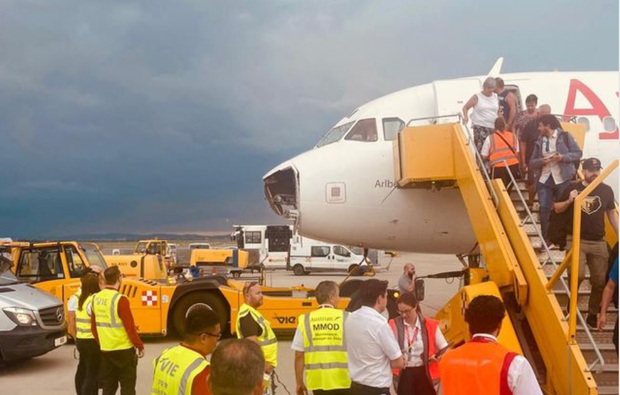CBS News
It only takes 5 seconds of hail to damage an airplane mid-flight, expert says. Photos show how destructive it can be.

An Austrian Airlines flight went viral this week after it flew through a hailstorm on Sunday that ripped off part of the plane’s nose and shattered its cockpit windows. And one expert tells CBS News that while incidents like this are rare, they can happen very easily — and very fast.
The incident involved Austrian Airlines flight OS434, en route from Palma de Mallorca to Vienna, the airline told CBS News. As seen in photos shared by passengers and passersby, the airline also confirmed that the two front cockpit windows and the aircraft nose, also known as the radome, were damaged, as well as “some coverings.” An investigation is now underway.
Anonymous via Storyful
“Due to the damage, a Mayday distress call was made,” an airline spokesperson said. “The aircraft was able to land safely at Vienna-Schwechat Airport. All passengers on the flight were unharmed.”
The spokesperson also confirmed that “the incident lasted only a few seconds.” According to meteorologist Renny Vandewege, general manager of weather and climate intelligence at DTN, that’s all it takes to cause damage.
He told CBS News that “because of an airplane’s high speed, hail doesn’t have to be all that large to wield damage to an aircraft.”
“The radome, at the nose of the plane, is particularly vulnerable because of the thin material used on that part of the plane,” he said. “Because of the aircraft speed, only as little as a 5-second exposure to a hail shaft can shatter noses and cockpit windows.”
Anonymous via Storyful
However, he added that few airplanes ever get caught in hail shafts because of the onboard radar systems. In most situations, these kinds of weather systems are avoided, he said.
Austrian Airlines told CBS News that Sunday’s situation happened after the plane encountered a thunderstorm cell while it was approaching Vienna, and that “according to the cockpit crew, [it] was not visible on the weather radar.” Single-cell thunderstorms, according to NOAA’s National Severe Storms Laboratory, are “small, brief, weak storms that grow and die within an hour or so” and are known to produce brief heavy rain and lightning.
It’s the thunderstorm core where things can be particularly dangerous, Vandewege said, as that’s where the updraft is at a maximum.
“It is the input of the energy source of the storm originating at the surface where the storm ingests warm moist air,” he said. “…These updrafts are what enables storms to produce hail because they can circulate ice up and down with the storm until it is too heavy to circulate. Therefore, the storms with the strongest updrafts can produce the largest hail.”
Anonymous via Storyful
As global temperatures rise, so does the frequency and intensity of extreme weather, including thunderstorms. And while flying through hail can quickly become damaging, Vandewege said that it doesn’t mean flying isn’t safe.
He told CBS News that building materials “are ever evolving” to make aircraft “lighter and tougher,” and that the information and technology used to avoid hail shafts is also undergoing substantial advancement.
“Of course, keeping your seatbelt on, light or not, is also recommended,” he said. “…Considering the level of advancement of avoidance technology, I don’t think there is any more reason to fear safety from thunderstorms than before. In fact, the past was more dangerous from relying on weaker technology for avoidance.”
CBS News
What to know about the new deal to avoid a government shutdown and Trump’s influence on it

Watch CBS News
Be the first to know
Get browser notifications for breaking news, live events, and exclusive reporting.
CBS News
Manchin says he doesn’t think the government will shut down

Watch CBS News
Be the first to know
Get browser notifications for breaking news, live events, and exclusive reporting.
CBS News
Rich McCormick says he is a “hard no” on the new spending bill

Watch CBS News
Be the first to know
Get browser notifications for breaking news, live events, and exclusive reporting.










